KUALA LUMPUR, 11 May 2021: AirAsia Group’s first-quarter 2021 operating results paint a depressing picture with passengers carried down 90% when compared with Q1 2020.
Reflecting the dire outlook facing the region’s airlines, AirAsia Group carried just over 900,000 passengers during Q1 compared to 9.8 million during the first quarter of 2021.

The airline focused on comparisons between February and March 2021 rather than by the full quarter in its official statement.
It read: “On a month-to-month basis, key operational metrics progressed positively in March 2021 as compared to February 2021, with an 84% increase in passengers carried by AirAsia Malaysia, 57% increase in passengers carried for AirAsia Philippines, 29% increase in passengers carried by AirAsia Indonesia, while AirAsia Thailand more than doubled its number of passengers carried.
“AirAsia expects to see solid domestic demand in its key ASEAN markets in the next few quarters as the majority of the population receives their vaccinations and due to strong pent up demand.”
But the comparison of first quarter 2021 with Q1 2020 showed lines of dramatic declines, a trend that is likely to continue well into the second quarter as more drastic lockdown measures unfold in key markets such as Thailand, India, Malaysia and the Philippines.
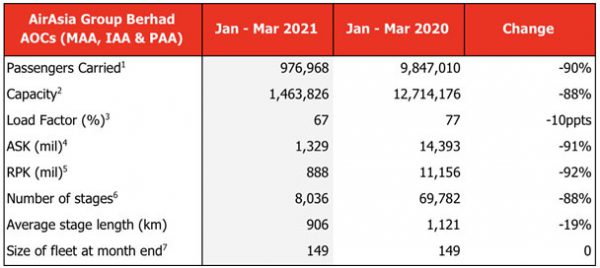
The quarter by quarter comparisons showed the group uplift capacity (number of seats) flown plummeted 88% to just 1,463,826 in Q1 2021 compared with 12,714,176 seats in Q1 2020.
Revenue Passenger Kilometres (RPK), a measure of the volume of passengers carried in Q1 2021, stood at 888 compared with 11,156, down by a dramatic 92%.
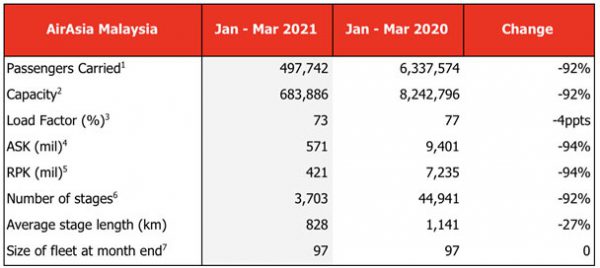
Though travel demand during the quarter was softened by the lockdown and interstate travel restrictions imposed since January 2021, AirAsia Malaysia said it was encouraged by statistics seen in March 2021 when the load factor improved by nine percentage points to 76%. AirAsia Malaysia is “optimistic that the ongoing inoculation drive in Malaysia will lead to a stronger and sustainable recovery this year.”
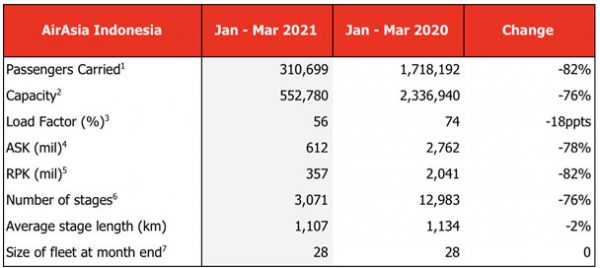
AirAsia Indonesia gained a 29% increase in passengers carried and achieved an improvement of two percentage points in load factor for March 2021 compared to February 2021, but the quarter-on-quarter comparison confirmed an overall decline of 82% in passengers carried.
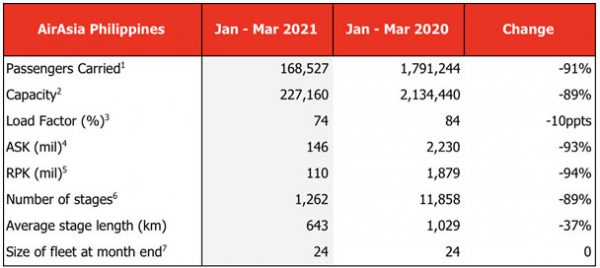
AirAsia Philippines grew its passenger numbers by 57% in March 2021 when compared to February 2021. This resulted in an 81% load factor in March 2021. But the quarter-on-quarter results reflected the same declines reported by the rest of the group’s airlines. Passengers carried in Q1 2021 clocked 168,526 compared with 1,721 244 during Q1 2020, down by 91%.
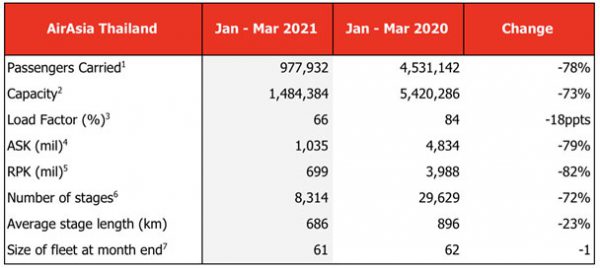
AirAsia Thailand posted a 78% quarter-on-quarter decline in passengers carried due to lower travel demand caused by the second Covid-19 wave, which began in December 2020. That wave has since been overtaken by a more contagious third surge that hit the country in early April, doubling the death rate over nine days ending 7 May.
While the February to March comparisons may have raised hopes that the turnaround had begun, the overall trend clearly stated in quarter-on-quarter comparison suggest it’s a false dawn.
AirAsia correctly points to the accelerated rollout of vaccine programmes across Southeast Asia, but the full impact on Covid-19 infection, hospitalisation and fatality rates will not kick in to possibly the third and fourth quarters. In the meantime, lockdown measures fluctuate in intensity, dampening travel demand and movements.








they should be looking after regular clients, who would then consider using them in future. We have about 20 refunds outstanding from 2019/20 and will not be rebooking til we’ve received our money back!